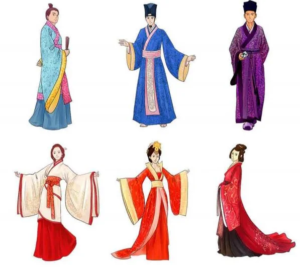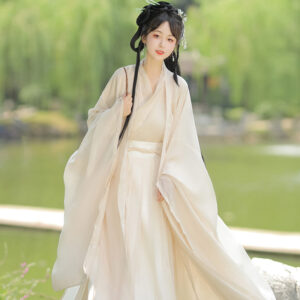

There were specific Hanfu styles for mourning or remembrance in ancient China, characterized by simplicity, a predominant use of white color, and symbolic patterns. Here’s an overview of how Hanfu was adapted for mourning:
1. Characteristics of Mourning Hanfu
- Simplicity: Mourning attire was designed to be plain and unadorned, reflecting the somber nature of grief. The focus was on minimalism rather than elaborate designs.
- Color: White was the primary color associated with mourning in traditional Chinese culture. It symbolizes purity and the transition from life to death, making it appropriate for funeral attire.
2. Evolution of Styles
- Early Han Dynasty: Initially, mourning garments were quite simple, consisting of basic robes without embellishments. As time progressed, these garments evolved to incorporate more elaborate designs that still maintained a sense of restraint.
- Symbolic Patterns: By the middle of the Han Dynasty, mourning Hanfu began to include specific motifs that conveyed deeper meanings related to the mourner’s relationship with the deceased. For example:
- Cloud Patterns: Symbolized the ascending spirit.
- Wave Motifs: Represented the soul’s journey across the sea of bitterness, reflecting Buddhist teachings.
3. Role in Mourning Ceremonies
- Physical Manifestation of Grief: During traditional mourning ceremonies, Hanfu served as a physical representation of sorrow and respect for the deceased. The uniformity and simplicity of the attire allowed mourners to collectively express their grief.
- Rituals and Ceremonies: Specific rituals, such as the ‘Chao’ (a ceremony involving crying and wailing), were performed by family members dressed in mourning Hanfu. This attire played a crucial role in the solemnity of these occasions.
4. Symbolism Embedded in Mourning Hanfu
- Knotting Techniques: The way the cloth belt was knotted had significance; a looser knot symbolized the loosening of earthly ties and a connection to the spirit world.
- Mourning Bands (Dai): A mourning band worn around the arm indicated the mourner’s relationship with the deceased. The length and position of this band varied according to familial hierarchy, visually representing levels of grief within the family.
5. Contrast with Everyday Hanfu
- Mourning Hanfu starkly contrasts with everyday Hanfu styles, which celebrate life through vibrant colors and intricate designs. While everyday attire reflects joy and social complexities, mourning attire provides a respectful and subdued way to express grief.
Conclusion
The specific styles of Hanfu used for mourning are deeply rooted in cultural practices and beliefs surrounding death and remembrance in ancient China. These garments not only served practical purposes during times of grief but also embodied profound symbolic meanings that reflected societal values regarding life, death, and familial relationships.
Share this post
Facebook
Twitter
LinkedIn
Pinterest
Recent Posts


What were the key features of Hanfu during the Tang Dynasty?
October 24, 2024

How did Hanfu styles vary during different Chinese dynasties?
October 24, 2024

What accessories are typically worn with Hanfu?
October 24, 2024

How do you choose the right Hanfu for different seasons?
October 24, 2024

Newsletter
Subscribe for our monthly newsletter to stay updated
Popular Categories
Related Post
Sed aliquam, tortor et sodales malesuada, lorem leo luctus tellus, quis interdum eros nibh in nunc. Cras dignissim malesuada, lorem leo luctus

What are the winter hanfu called?
October 24, 2024

What were the key features of Hanfu during the Tang Dynasty?
October 24, 2024

How did Hanfu styles vary during different Chinese dynasties?
October 24, 2024

What accessories are typically worn with Hanfu?
October 24, 2024

